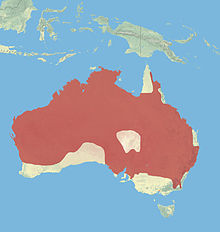- Eastern Wallaroo
-
Wallaroo[1] 
Conservation status Scientific classification Kingdom: Animalia Phylum: Chordata Class: Mammalia Infraclass: Marsupialia Order: Diprotodontia Family: Macropodidae Genus: Macropus Species: M. robustus Binomial name Macropus robustus
Gould, 1841Subspecies - M. r. erubescens
- M. r. isabellinus
- M. r. robustus
- M. r. woodwardi'

Eastern Wallaroo range The Eastern Wallaroo (Macropus robustus robustus) also known as the Common Wallaroo or the Hill Wallaroo is part of the Wallaroo family (Macropus robustus). It is a large, variable species of macropod (same as the Kangaroo).
Many mistakenly believe that the Eastern Wallaroo and the Euro the same species, but they are actually two distinct sub-species. The Eastern Wallaroo (Macropus robustus robustus)- which is grey in colour - occupies the eastern slopes of the Great Dividing Range and the Euro (Macropus robustus erubescens) - rufous in colour - occupies land westward.
The photograph at right is a Euro.
The Eastern Wallaroo is mostly nocturnal and solitary, and is one of the more common macropods. It makes a loud hissing noise and some subspecies are sexually dimorphic, like most wallaroos.[3]
There are four subspecies of the Wallaroo:[1]
- M. r. robustus - Found in eastern Australia, males of this subspecies have dark fur, almost resembling Woodward's Wallaroo (Macropus bernardus). Females are lighter, being almost sandy in colour.[3]
- M. r. erubescens - Found on covering most of its remaining range, this subspecies is variable, but mostly brownish in colour.[3]
- M. r. isabellinus - This subspecies is restricted to Barrow Island in Western Australia, and is comparatively small. It is uniformly reddish brown.[3]
- M. r. woodwardi - This subspecies is found in the Kimberley region of Western Australia and in a band running through Northern Territory. It is the palest subspecies and is a dull brown-grey colour.[3]
The Eastern Wallaroo as a species is not considered to be threatened, but the Barrow Island subspecies (M. r. isabellinus) is classified as vulnerable.[2]
References
- ^ a b Groves, C. (2005). Wilson, D. E., & Reeder, D. M, eds. ed. Mammal Species of the World (3rd ed.). Baltimore: Johns Hopkins University Press. pp. 65. OCLC 62265494. ISBN 0-801-88221-4. http://www.bucknell.edu/msw3.
- ^ a b Ellis, M., Menkhorst, P., van Weenen, J., Burbidge, A., Copley, P., Denny, M., Woinarski, J., Mawson, P. & Morris, K. (2008). Macropus robustus. In: IUCN 2008. IUCN Red List of Threatened Species. Downloaded on 28 December 2008. Database entry includes justification for why this species is of least concern
- ^ a b c d e Menkhorst, Peter (2001). A Field Guide to the Mammals of Australia. Oxford University Press. p. 118.
External links
- Animal Diversity Web
- Sedgwick County Zoo on Wallaroos
- Photos at ARKive.
- Fourth Crossing Wildlife - The Wallaroo and the Euro
Categories:- IUCN Red List least concern species
- Macropods
- Mammals of Western Australia
- Mammals of South Australia
- Mammals of the Northern Territory
- Mammals of New South Wales
- Mammals of Victoria (Australia)
- Marsupials of Australia
- Megafauna of Australia
- Diprotodont stubs
- Western Australia stubs
Wikimedia Foundation. 2010.

